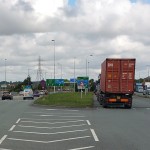Sector - Energy, Fuel & Utilities
Highways England harness solar energy to illuminate the A38

With the Great British summertime in full swing, Highways England has fitted more than 4,500 solar road studs to capture sunlight and illuminate the A38 at night.
The new addition forms part of an £8.5 million improvement programme spanning the A38 between Ripley and Junction 28 of the M1 near Mansfield – a stretch of tarmac traversed by some 23,000 vehicle each day. Crucially, the studs are effective in rain, mist or fog – all staples of the UK climate – and a four-hour charge can provide enough power for 200 hours of light.
Traditionally, road studs have required car headlights to illuminate their surface. According to Highways England, this means headlights can be seen up to 90 metres away, giving drivers travelling at 60 miles per hour a mere three seconds to react to conditions ahead.
These new studs are solar powered however with a panel absorbing energy during the day. Throughout the night they generate their own light through a battery powered LED and can be seen up to 900 metres away, giving drivers travelling at 60 miles per hour 30 seconds or more to react.
The new studs are also much more durable, lasting up to five years longer than the standard variant. They require less maintenance during their lifetime and at only four millimetres in height they are much safer for motorcycles.
“We’re always looking for new ways to further improve journeys and safety for drivers and this is a great example of that,” said Highways England Project Manager, Matthew Carruthers. “This section of carriageway has no street lighting so the solar road studs and improved lane markings make a real difference. At the same time the new technology is more durable, meaning less disruption for motorists in the long term thanks to fewer roadworks.”
Additional improvements along the A38 include high visibility lane markings that make it easier for drivers at night or in adverse weather conditions, and coloured high friction surfaces that reduce the risk of skidding.
If you would like to read more articles like this then please click here.
Related Articles
More Energy, Fuel & Utilities News
- Belfast Harbour Secured as £100 Million Hub for Major Offshore Wind Projects
10 Dec 25
Belfast Harbour is set to become the primary assembly and construction hub for two of
- Wylfa chosen as SMR site
2 Dec 25
Great British Energy has confirmed that Wylfa on Anglesey has been selected as the site
- £10M for EV charging tech
27 Nov 25
New cutting-edge technology, backed by £10 million of government funding will allow electric vehicle (EV)






